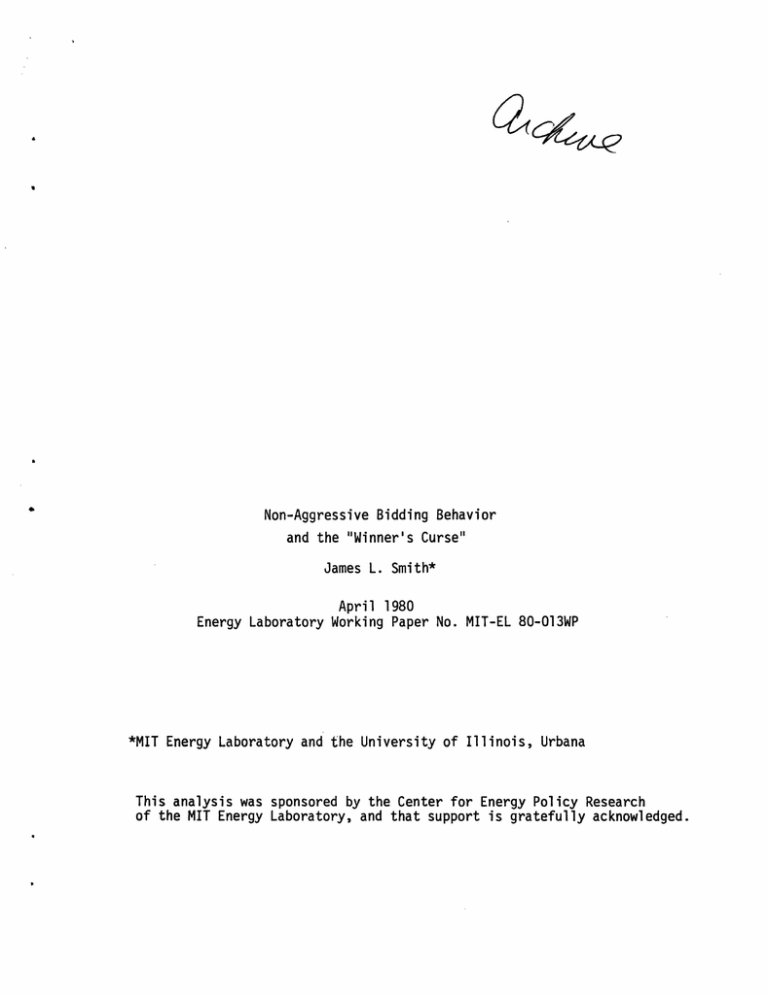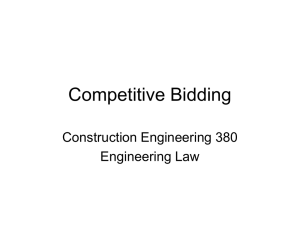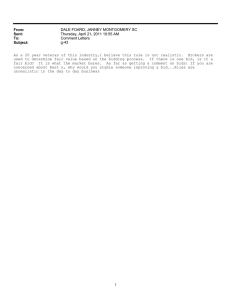( 4
advertisement

( 4
Non-Aggressive Bidding Behavior
and the "Winner's Curse"
James L. Smith*
April 1980
Energy Laboratory Working Paper No. MIT-EL 80-013WP
*MIT Energy Laboratory and the University of Illinois, Urbana
This analysis was sponsored by the Center for Energy Policy Research
of the MIT Energy Laboratory, and that support is gratefully acknowledged.
I
NON-AGGRESSIVE BIDDING BEHAVIOR AND THE "WINNER'S CURSE"
James L. Smith
Center for Energy Policy Research
Massachusetts Institute of Technology
Abstract
Previous authors have noted a curious result that arises in the
context of sealed-bid auctions: in certain situations it is in
the bidder's interest to respond non-aggressively to increased
competition. We consider a decision-theoretic formulation of the
bidder's problem, and derive necessary conditions for the choice
of a non-aggressive bidding strategy. The resulting conditions
relate closely to a phenomenon that has been described rather
loosely by bidding practitioners as the "winner's curse". In the
course of this paper we develop a specific definition of the winner's
curse, and demonstrate how it affects the firm's competitive
behavior.
NON-AGGRESSIVE BIDDING BEHAVIOR AND THE "WINNER'S CURSE"
James L. Smith*
A notion that is central to the study of industrial structure and
market performance is that the entrance of additional competitors to a
market is likely to enhance the level of competition which prevails there.
This effect may be reflected in various aspects of the industry's conduct,
but perhaps most prominently in the individual pricing behavior adopted
by its members.
The common presumption is that additional rivals will
engender more aggressive pricing behavior on the part of all participants.
The apparent generality of this conclusion has been established by studies
of the competitive pricing response in diverse market situations, including
markets for both differentiated and undifferentiated products, and markets
characterized by varying degrees of cooperative interaction among firms.
In each case, the equilibrium
price
offered
by all firms
can be shown
to
decrease and ultimately converge to the level of marginal cost as the
number of rivals increases.
A possible exception to this paradigm arises in the context of sealedbid auction markets, where independent firms compete either for the right
*I am grateful to Keith Brown, Michael Fuerst, Edward Rice, Michael
Rothkopf and an anonymous referee for comments on an earlier draft.
This research was supported in part
no. 14-08-0001-G-419. However, the
are those of the author, and should
representing the official policies,
U.S. Government.
1
See, for example:
Phillips
[1970]; and Friedman [1977,
by the U.S. Geological Survey, grant
views and conclusions reported here
not be interpreted as necessarily
either expressed or implied, of the
[1962, p. 29]; Shubik
p. 30].
[1970];
Silberston
-2-
to provide some service ("buyer's auction"), or to acquire an item of
potential value ("seller's auction").
specific
examples
in which
Several previous studies provide
it is in the firm's
aggressively as the number of rivals increases.
interest
to bid less
The potential optimality
of such behavior was first suggested by Rothkopf [1969], who found that
non-aggressive strategies constitute a Nash equilibrium for a particular
set of n-person bidding games.
Further cases in which equilibrium behav-
ior consists of non-aggressive bidding strategies have subsequently been
reported by Zinn, Lesso, and Givens [1975], and by Reece [1977].
Simi-
larly, Capen, Clapp, and Campbell [1971], and Dougherty and Nozaki [1975]
have investigated the performance of alternative bidding strategies in a
partial equilibrium framework (where competitors' actions are regarded as
exogenous), and provide additional examples where expected profit is maximized by a non-aggressive response to competition.
Non-aggressive bidding strategies are not appropriate in all bidding
environments.
The previous studies provide only isolated examples of the
phenomenon, and many counterexamples may be cited where it is in the firm's
interest to respond aggressively to additional competition (e.g., Vickrey
[1961]).
The objective of the present paper is to characterize more
generally the firm's choice between aggressive and non-aggressive bidding
strategies.
We consider a decision-theoretic formulation of the firm's
bidding problem, and derive necessary conditions for the optimality of a
non-aggressive bidding strategy.
The resulting conditions relate closely
to a phenomenon that has been described rather loosely by bidding practitioners as the "winner's curse."
In the course of this paper we develop
a specific definition of the winner's curse, and demonstrate how it affects
the firm's competitive behavior.
-3-
The Bidder's Problem
We formulate the firm's decision problem in fairly general terms.
The firm must compete against n opposing bidders to acquire an item of
uncertain value, v.
The firm will select a bid, b, that maximizes the
expected profit obtained in the auction.
The nature of our results would
be essentially unchanged under the convention of maximizing utility.
The bid tendered
by the
th competitor,
denoted
z i , is assumed
to
follow a conditional distribution function, G(.Iv), which depends on the
item's true underlying value.
The only restriction placed on this distri-
bution is that items of higher value are presumed more likely to draw high
bids:
(1)
G(zjv 1 )
G(zlv
<
2 );
for all z, with
v1 > v2.
This implies that rivals' bids, once revealed, are informative regarding
the item's true value.
This aspect of the bidding environment is critical,
as we demonstrate below, to the choice between aggressive and non-aggressive bidding strategies.
For comparison, the bidding models of Vickrey
[1961], Rothkopf [1969], and Reece [1977] are also structured such that
rivals' bids are informative, but in each case the specification is more
restrictive.
For example, Rothkopf assumes that each competitor enters
a bid that reflects a "sample" or indicator of the item's true value,
drawn from an unbiased Weibull distribution.
The models of Vickrey and
Reece are similar, but respectively substitute rectangular and lognormal
sampling distributions for the Weibull.
The present analysis does not
restrict the form of the sampling distribution, nor require that it be
unbiased.
-4-
The highest competing bid, denoted x, is defined simply as x = max
{zl ,
.
..
,
Zn}.
This random variable follows the extreme value distribu-
tion, H(.v,n);
(2)
H(xlv,n)
=
[G(xlv)]n.
The density of the highest competing bid may then be written as h(Iv,n):
(3)
h(xlv,n)
=
ng(xiv)-[G(xlv)]
n- l
,
... where g(.Iv) is the density of each firm's bid.
If we represent the firm's own beliefs regarding the item's true value by
the prior density, p(),
we may then write explicitly the joint density
of highest competing bid and underlying value, f(v,xin):
(4)
f(v,xfn)
=
h(xlv,n)p(v)
n - 1.
= np(v).g(xlv).[G(xlv)]
l
As Equation (4) demonstrates, the random variables v and x cannot
generally be regarded as statistically independent.
This is essentially
what it means for the competitors' bids to be informative.
One implica-
tion is that if the amount of the highest competing bid were revealed, our
firm would then revise its appraisal of the item's value to incorporate
this additional information.
The two variables would truly be indepen-
dent only if the firm were prevented from relating the magnitude of
competing bids to the underlying value of the contested item.
This would
occur, for example, if the separate bidders were to enter the auction
with a consensus of opinion regarding the item's value; because then the
range of observed bids could only be interpreted as the manifestation of
divergent bidding strategies, not as new information regarding the item's
value.
A special case of consensus beliefs is, of course, that in which
the item's value is known with certainty.
-5-
The firm's objective is to maximize expected profits by appropriate
choice of bid:1
o b*
(5)
max:
E[7(b)]
=
f
f
(v-b)-f(v,xjn)
dx dv.
00
(b)
The optimal bid, b*, must satisfy the first-order condition obtained upon
differentiation of Equation (5), which appears after simplification:
(6)
~(b*ln)
-
v(b*]n) - b*;
o b*
f f
00
... where:
(b*ln)
f(v,xln) dv dx
=
f f(v,b*ln) dv
0
and:
v(b*In)
=
E[vlx=b*,n].
Each component of Equation (6) has an intuitive interpretation.
function
The
(b*ln) is the inverse of the "failure rate" function, which
represents the probability that the bid, b*, will be defeated, given
that any larger bid would have been successful.
The expression v(b*ln)
represents the posterior expectation of the item's value, conditional on
the event that the highest of n competing bids equals precisely the value
b*.
The Winner's Curse
One implication of Equation (6) is that the optimal strategy requires
the firm to underbid its expectation of the item's value.
directly since the degree of underbidding (b*)
This follows
is equated to a probability
We abstract from possible costs of preparing the bid, so profit is zero
if the auction is not won. Because the competing bid distribution is
assumed continuous throughout, the probability of a tie is zero.
-6-
density,
p(b*ln),which is necessarily positive.
However, the nature of
the underbidding phenomenon is less straightforward than the simple equation might suggest.
It is not sufficient
its a priori expectation of value.
for the firm to bid less than
Rather, Equation (6) requires the
firm to enter a bid which, if successful, will not exceed its posterior
expectation which incorporates the knowledge that none of its rivals were
prepared to bid any higher.
In other words, the underbidding strategy
provides a course of action that sustains the winner's confidence even
in the equivocal but inevitable event that no other bidder shows a
comparable interest in the contested item.
This discussion indirectly raises the question of the winner's curse.
In the auction of any item whose value is uncertain, there is a possibility
that the winning bidder is lead to that position because he has most overestimated the item's true value.1
In retrospect, the winner will revalue
the item in accordance with the revealed bids of his rivals, all of whom
bid lower than himself.
Consequently, the winner's appraisal may be
diminished by the very act of winning.
If the firm does not respect the
underbidding rule described by Equation (6), it may enter a bid that
exceeds its final appraisal of the item's value, even though the bid
started out well below the initial (pre-auction) estimate.
In this
unfortunate event, the firm would regret its action immediately upon
winning the auction, and could be said to have experienced the "winner's
curse."
Brown [1974] has discussed this tendency in the context of capital
budgeting decisions, where "acceptable" investment projects may be
those whose returns have been most over-estimated.
-7-
The firm's desire to avoid the winner's curse not only motivates the
practice of underbidding, but may in certain cases induce the firm to bid
less aggressively as the degree of competition increases.
An intuitive
explanation of this paradoxical result is that the posterior expectation,
v, which
imposes
a natural
ceiling
as the number of bidders increases.
on the bid, is itself
pushed
downward
Greater competition diminishes the
perceived value of winning because the act of outbidding a relatively
large number of rivals strongly suggests that the firm has been unduly
optimistic.
Because greater competition diminishes the perceived value
of winning, it may also reduce the firm's willingness to pay and ultimately
cause the bid to be lowered.
The formal
elements
which
enter
this decision
bid as a function
of the number
problem are discussed below.
Equation
(6) characterizes
of competitors.
the optimal
Upon total differentiation this relation also describes
the firm's response to additional competitors:
v
db*
(7)
dn
n
1
qf
n
V
... where
n
n (b*ln),
n~~~~
'n
etc.
If the sign of db*/dn were positive, the firm could be said to display an
aggressive competitive response, in accordance with conventional theory.
Conversely, if the sign were negative, the firm would display a nonaggressive response.
Determination of the sign of db*/dn is simplified by two observations:
(1)
The denominator, 1-vb-b,
must, by the second-order optimality
conditions, be positive.
Consequently, the sign of db*/dn is
that of the numerator, vn- n.
-8-
(2)
The sign of
n must be negative under fairly broad assumptions
regarding the distribution of competing bids.1
Several conclusions follow.
First, a sufficient condition for the firm
to display an aggressive response to competition is that its appraisal
of the item's value be independent of rivals' behavior (which implies
n = 0).
This condition would be satisfied, for example, if the item's
value were known with certainty, or if all firms were to share common
indications (samples) of its unknown value.
Conversely, necessary conditions for a non-aggressive response to
competition are that the item's value be uncertain, and that rivals' bids
reflect independent indications of the true underlying value.
necessary conditions are satisfied by the models of Vickrey
Rothkopf [1969], and Reece [1977].
These
1961],
They are satisfied also in the
present analysis by the assumption that rival bids are drawn independently from the conditional distribution, G(.Iv).
sufficient
to prove
that vn < 0, as demonstrated
This assumption is
in the appendix.
That
is, under the conditions of uncertainty described here, rivals' bids do
convey some information regarding the item's value, and the winner's
posterior valuation is necessarily a decreasing function of the number
of opposing bidders.
Consequently, there is a potential for the firm
to adopt a non-aggressive competitive response.
The sufficient condition for a non-aggressive response requires not
only that Vn be negative, but also be of greater absolute magnitude than
1A sufficient (not necessary) condition for this result is that the probability of a competing bid falling in any interval above b* be increased
by the advent of additional competition. That is, fn(v,xln) > ; for all
v,
and
x > b*.
-9-
On (i.e., the sensitivity of the hazard rate to the degree of competition).
Consequently, if the non-aggressive response is to be observed, the firm
must not only be impressionable, but its posterior appraisal must be relatively volatile, as when the firm places little confidence in its own
information.
Not surprisingly, this sufficient condition for non-aggres-
sive behavior describes the bidding environment in which the firm is most
vulnerable
to the winner's
curse.
Summary
We have described the conditions under which an individual bidder
would adopt a non-aggressive competitive bidding strategy.
The conditions
presuppose uncertainty regarding both the magnitude of the highest competing
bid and the value of the contested item.
The interaction of these risks
propagates a phenomenon known as the winner's curse.
It is the firm's
motivation to avoid the "curse" that leads to the adoption of non-aggressive competitive strategies.
The present paper constitutes a partial equilibrium analysis because
we have focused on an individual firm's response to attributes of the
market that are taken as exogenous.
However, dynamic interaction among
firms should be expected to influence these parameters and the resulting
configuration
another.
of bids as the market
proceeds
from one equilibrium
to
Therefore, the short-term comparative static response of the
individual--be it aggressive or not--is not necessarily a reliable guide
to the behavioral patterns that would emerge if all firms were permitted
to react simultaneously.
The question arises whether the non-aggressive
bidding strategies explored here would indeed constitute viable equilibrium strategies if adopted by all firms.
The answer seems clearly to
-10-
Imagine that each individual bidder were to reduce
be in the affirmative.
the amount
of its
described above.
bid
upon the arrival
of a new competitor,
in the manner
These mutual adjustments, if anticipated, would cause
each bidder to reduce its expectation of highest competing bid, and induce
a second round of downward bid revisions that reinforces the initial
adjustment attributed to the winner's curse.
The bidding simulation
studies cited above provide examples of this phenomenon, where the Nash
strategy
for each firm
is to reduce
firms enter the auction.
the level of its bid as additional
By focussing on the individual firm's decision
calculus we have been able to gain some insight regarding the economic
rationale for this type of behavior.
-11-
APPENDIX:
THE POSTERIOR VALUATION
We present a theorem which demonstrates under general conditions that
the winning bidder's posterior valuation is necessarily a decreasing function of the number of rivals:
tained here:
vn <
.
The notation of the text is main-
the number of opposing bidders is represented by n, and x
denotes the value of the highest competing bid.
Individual competing
bids are assumed to be generated independently by the conditional distribution function, G( Iv), where v denotes the true value of the contested
item.
The theorem simply states:
if it is possible to order the bid distri-
butions, G(.Iv), in terms of stochastic dominance on the basis of parameter
v; then it must also be possible to order the posterior value distributions,
H( Ix,n), in terms of stochastic dominance on the basis of parameter n.
The restriction to stochastically ordered bid distributions corresponds
to our previous assumption [Equation (1) of the text] that items of higher
value are more likely to draw high bids.
Theorem
Let (z ...
,
zn ) represent an independently and identically distributed sample rawn rom parent distribution G(-Iv); this being one of a
family of distribution functions indexed by parameter v, and having continuous density g( Iv). Let x represent the maximum value obtained in
the sample. Finally, let F(-.Ix,n)represent the posterior distribution
of v conditional on the sample information (x,n), and itself having continuous density f(.Ix,n). Then, if G(zjv1 ) > G(zlv2 ) for all z, with
vl < v2; it follows
that
F(vlx,nl)
> F(vlx,n 2 ) for all v, with
n
> n2 .
Technically, the value of the item must belong to the parameter class
used to define Lehmann's second category of well-ordered distributions
[1955, p. 400].
-12-
Proof
The theorem is established by proving the somewhat stronger proposition that, for n
(Al)
> n2, there exists some value, c, for which:
f(vlx,n 1 )
f(vlx,n 2 )
if and only
if
v
c;
that is, the posterior densities are "simply intertwined" in the sense of
Hammond [1974, p. 1052], with exactly one intersection at the point c.
The theorem follows immediately from this property of the posterior densities.
We begin by writing the likelihood of the extreme value, conditional
on v and n [Equation
(A2)
h(xlv,n)
(3) of the text]:
=
n- 1
n g(xlv)[G(xjv)]
The posterior density of v, conditional on x and n, may then be written:
g(x Iv)[G(x v)]n-p(v)
(A3)
f(vlx,n)
=
A(vlx,n)
:
;
00
n-I
f g(x I v) [G(xlv)]n lp(v)dv
~~~~B(x,n)
B(xn)
_00
where p(.) represents the prior distribution of v; and where we have
replaced the numerator and denominator in the final expression by the
terms A(vlx,n) and B(x,n), respectively.
To establish (Al) we characterize the distortion in the posterior
density f( Ix,n) induced by variations in n.
Specifically, we demon-
strate the existence of a value c for which:
(A4)
a f(vlx,n)
0
><
an
if and only
if
v
>
The derivative in (A4) is evaluated using (A3):
c.
-13-
a
ja
f(vlxn)
(A5)
n
= a A(vlx,n), etc.
' ~n'
where A
sgn
~~An
-B - A-B n
=
f(vlx,n) = sgn
;
Evaluation of (A5) reveals:
n[G(xv)
f(vxn)dv
- f]dv.
ff(vxn)ln[G(xlv)
Two remarks are sufficient to determine the sign of the expression on the
right.
Remark 1:
The expression cannot be uniformly positive (negative)
for all values of v, for then the derivative would be
positive (negative) throughout, which is impossible for
any proper density function.
Remark 2:
The value of the expression depends on v only through
the leading
term:
In G(xlv),
which
has been assumed
monotonically decreasing in v for fixed x.
From this it follows that a point c exists such that a
v
as
c.
f(vlx,n) > 0 as
By the continuity of f(vlx,n) it follows that f(vlx,n1 )
v > c.
QED
f(vjx,n2 )
-14-
REFERENCES
Brown, Keith C., "A Note on the Apparent Bias of Net Revenue Estimates
for Capital Investment Projects," The Journal of Finance. 1974,
29(4):1215-16.
Capen,
E. C., Clapp,
R. V., and Campbell,
W. M., "Competitive
Bidding
in High Risk Situations," Journal of Petroleum Technology.
June,
1971, pp. 641-53.
Dougherty, Elmer L., and Nozaki, M., "Determining Optimum Bid Fraction,"
Journal of Petroleum Technology. March, 1975, pp. 349-56.
Friedman, James W., Oligopoly and the Theory of Games.
North Holland Publishing Co., 1977.
Amsterdam:
Hammond, John S. III, "Simplifyirtgthe Choice Between Uncertain
Prospects
Where Preference is Nonlinear," Management Science.
1974,
20(7):1047-72.
Lehmann, E. L., "Ordered Families of Distributions," Annals of
Mathematical Statistics. 1955, 26(3):399-419.
Phillips, Almarin, Market Structure, Organization and Performance.
Cambridge, Mass.: Harvard University Press, 1962.
Reece, Douglas, K., "Leasing Offshore Oil: An Analysis of Alternative
Information and Bidding Systems," unpublished Ph.D. dissertation,
University of California, Berkeley, 1977.
Rothkopf, Michael H., "A Model of Rational Competitive Bidding,"
Management Science. 1969, 15(7):362-73.
Shubik, Martin, "Price Strategy Oligopoly: Limiting Behavior with
Product Differentiation," Western Economic Journal. 1970, 8(3):
226-32.
Silberston, Aubrey, "Price Behavior of Firms," Economic Journal.
80(319): 511-82.
1970,
Vickrey, William, "Counterspeculation, Auctions, and Competitive
Sealed Tenders," Journal of Finance. 1961, 16(1l):8-37.
Zinn, C. D., Lesso,
W. G., and Givens,
G. R., "OILSIM:
A Simulation
Model for Evaluation of Alternative Bidding Procedures," paper
presented at the American Society of Mechanical Engineers Winter
Annual Meeting, November 30, 1975.






